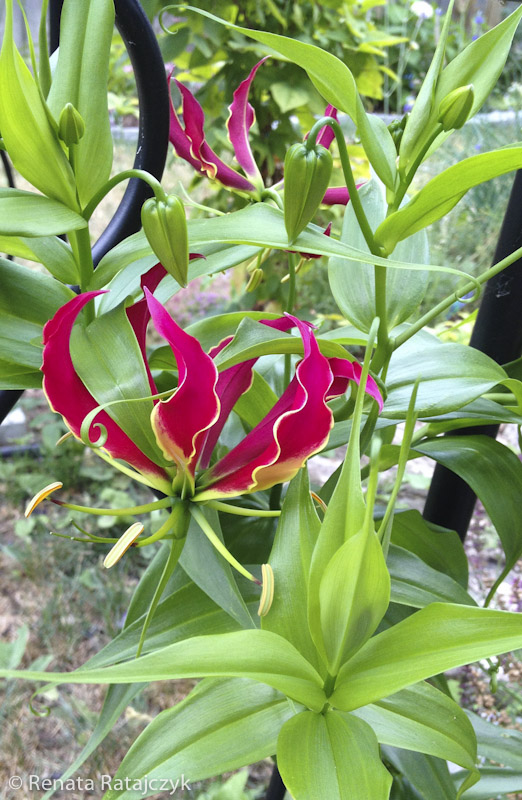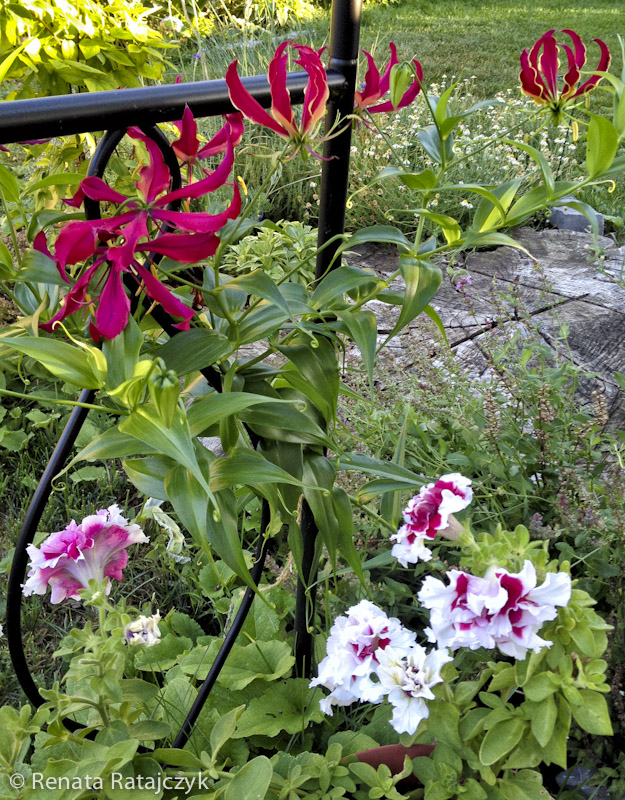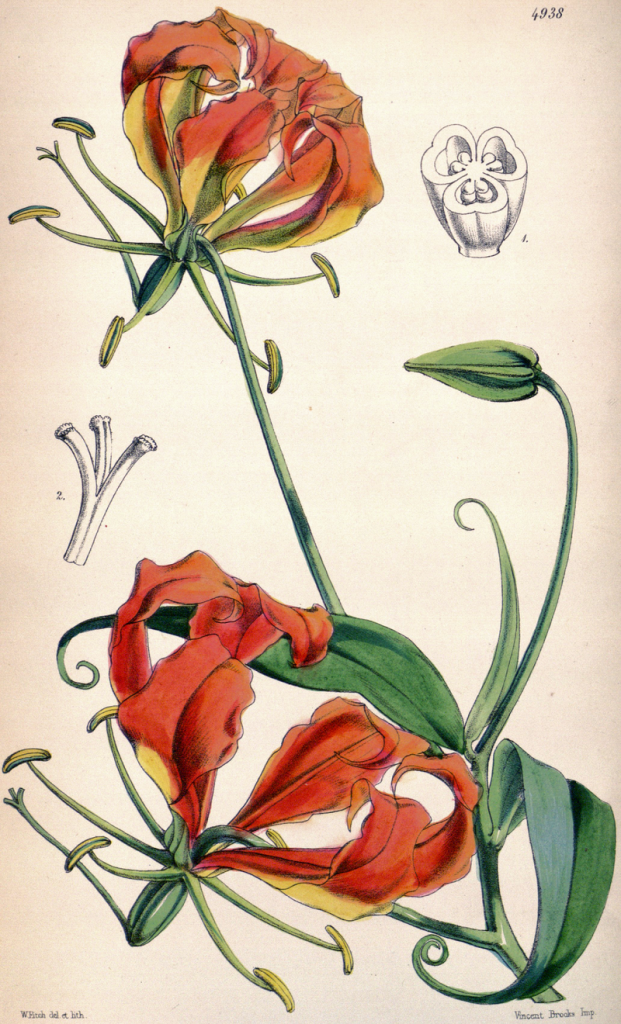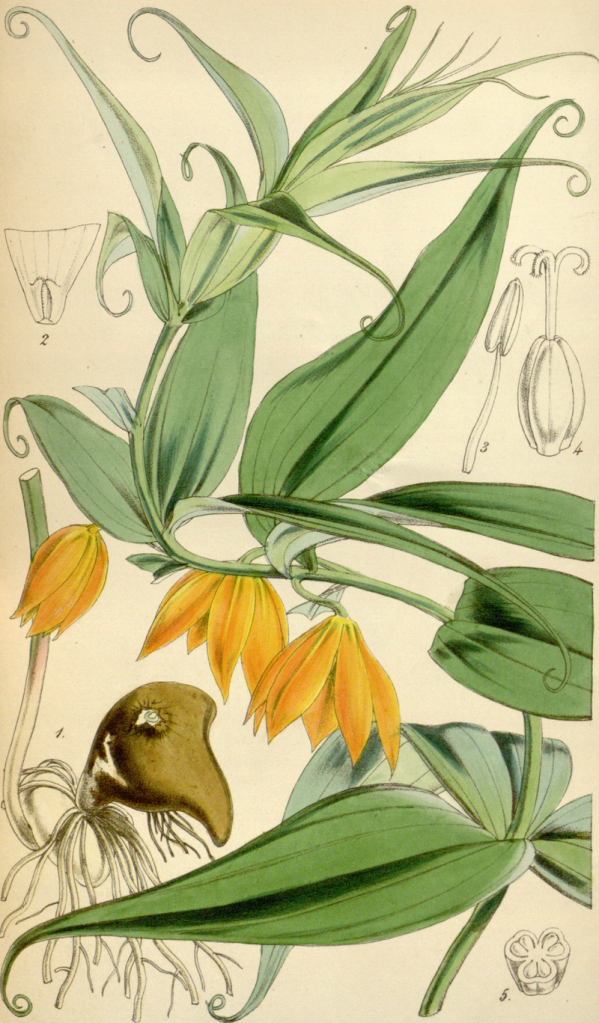
My Experience With Gloriosa Superba.
I would like to feature today one of my favorite climbers – Gloriosa superba (flame lily) – one of my favorite summer flowering plants. Where I live (zone 5b), now is the right time to plant tender summer bulbs and flowering rhizomes.
I have purchased a package with this exotic lily last year from one of the department stores. The package contained 2 tubers in pretty good condition. I have planted them sometimes in the beginning of June, about a week or so after the danger of last frost has past.
I placed one of the tubers in the middle of our garden pretty close to a decorative metal arch hoping it will climb over it. I have added some good quality lighter soil and a bit of composted manure to the planting hole. The tuber has to be planted horizontally with the growing bud facing up (if you can see it).
Initially for about 2-3 weeks there was no sign of any growth from the tuber, but finally the first leaves have appeared over the ground. Then my Gloriosa started to grow pretty fast. I have added some wires to the arch to help the flower climb on it. After another 3 weeks or so, about the middle of July, the first beautiful, exotic looking flower has appeared. I loved the way how it looked – six burgundy red raised petals with some yellow at the edges. The flowers of Gloriosa superba are quite large – about 3-4″in diameter.
It continued to grow to about 3-4 feet and more flowers have appeared soon. My Gloriosa was blooming for a few weeks. I was hoping it will be growing even higher and would climb to the top of the arch, but the flowers wilted and the plant was not growing any higher. Perhaps it was badly affected by the extremely hot and dry summer we had last year, despite the fact that I was watering it often to make sure it has enough moisture. Maybe it was getting too much strong sun in the middle of our garden or it was just a natural cycle of this plant.
Nevertheless, I think it made quite a wonderful display in our colder zone garden adding unique exotic beauty and elegance.

The other tuber, which I have planted on the left side of our garden in semi shade, didn’t sprout at all and remained dormant.
After the first frost, Gloriosa growing in the middle of our garden died and I wanted to lift its tuber to save it from freezing, but when I was trying to dig it up, I have discovered that it has grown much bigger and got stuck between roots of the death tree trunk. I would have to break it to take it out so I have decided to leave it there. I have just covered this place very well with a few inches of cedar mulch. So far there are no sign of life coming from this tuber, so I am afraid it probably got frozen during the winter.
I have lifted the other tuber, which I have discovered when taking out for the winter my dahlias tubers and I have stored it with some shredded wood chips during the colder season. I have recently planted it in a pot in light soil with peat moss and watered it hoping it will grow to a new plant. So far, I still have it at house and I don’t see any signs of life. I am not sure this tuber will grow to a new plant, but I hope it will. I will keep you posted in case it will bloom this year.
I think Gloriosa superba is certainly worth a try, unless you have small children or pets, which might like to eat it. All parts of the plant, but especially the underground tubers and the seeds are extremely poisonous since they contain colchicine and related alkaloids. They are dangerously toxic when ingested and contact with the stems and leaves can cause skin irritation, so it is better to use gloves or wash your hands after handling this plant.
I was touching my Gloriosa occasionally without gloves and didn’t notice any irritation, but I was washing my hands soon after I have touched it. The ingestion of flame lily has caused many accidental deaths. Certainly it is a not good idea to plant it close to edible plants, which might have somehow similar looking tubers.
By the way, I think all poisonous plants sold in stores should have some warning added on the package.
More Information About Gloriosa Superba (Flame Lily).

Flame lily belongs to “Gloriosa” genus and is widely spread in tropical and southern Africa and in tropical regions of Asia, but can also grow in some more temperate climate and is also found in parts of Europe, Australia and regions of USA. It warmer climate in can even grow in high mountains up to about 2,500 meters above sea level. In some areas (Australia, parts of USA) it can naturalize so well, that it is considered a weed, but in a few regions of other countries is now endangered (India, Bangladesh and Sri Lanka).
The flowers are usually red and yellow. There are also some related species with different colours of the flower. I attach one picture or related species below.
Besides being called Flame Lily, this plant also has a few other common English names: fire lily, gloriosa lily, superb lily, glory lily, climbing and creeping lily.
Gloriosa’s flower is the national flower of Zimbabwe, where is protected from illegal harvesting. It is also state flower (Kaanthal) of Tamil Nadu in southern India. In Tami Nadu its flowers are used in religious ceremonies and in many countries of Africa they are utilizes in magical rituals.
Its name “Gloriosa” means “full of glory”.
Gloriosa superba is perennial tuber in the areas where it can survive the winters. In tropical regions it grows during the rain season and goes dormant in the dry period. It can grow up to about 3-4 m (12 feet) long. Once the flowers are gone, the flower creates seeds capsules, which could be up to about 6 cm (about 2.5 “) long. Indeed I have found some of such capsules on my plant, but I think they were smaller. I have collected some in case, but so far didn’t try to plant any of them still hoping the second tuber I have planted will sprout this year.
This plant is widely cultivated not only for its very ornamental flowers but also for medicinal properties, which I will shortly describe below. You might have seen, and maybe even purchased the flower Gloriosa from your local florist.
Medicinal Properties of Gloriosa Superba (Flame Lily).
Despite being quite poisonous, this plant has medicinal properties and is widely used in traditional medicine, especially in tropical Africa, Asia and Ayurvedic medicine of India. One of its active ingredients is alkaloid colchicine, which when administered at the right dose, has been used to treat a variety of diseases, including intestinal worms, gout, wounds, an antidote for snake bite etc. Colchicine has been also studied in relation to cell division and cancer treatment. Please never self-medicate with this plant and always consult the professional doctor if you think it can be helpful to you.
One of the reason Flame lily is in decline in some areas is because its seeds and tubers are over-collected for their medicinal properties. It is commercially cultivated in southern India, but it is estimated that 75% of the plant is collected from the wild.
How to Cultivate Gloriosa Lily.
They like fertile, well drained soil in full sun or partial shade (it needs 6-8 hours of direct sunlight per day). In hotter climate, as with many other climbers, it is best to shade its roots from the direct sun and it might also like some protection from the strong afternoon light. They are tropical plants and only hardy in zones 10-11. They can survive in zone 9 with mulch protection. It is rather unlikely they will survive if left in the ground in colder zones, so tubers should be lifted after the first frost when the upper part of plat dies. They need trellis or other support to climb.
Prepare the place for your Gloriosa plant by digging in the ground to about 8″ and if necessary, adding to the soil more organic matter, such as peat moss, compost or composted manure to improve drainage and add nutrients. Plant your lily tuber when the danger of frost has pasted and place it horizontally at the depth of 2-4″ about 3-4″ from its support (trellis or otherwise). If you have more than one tuber, space them about 6-8″ apart. Cover the tubers and water well. Keep and eye on the soil of your Gloriosa lily so it will not dry out. In about 2-3 weeks you should see the first shoots above the ground. Do not allow soil to dry, but also don’t overwater or the tuber can rot. Train the plant along its support. Fertilize it with diluted flower fertilizer every 2 weeks or so with. Once the plant are killed by the first frost, lift the tubers and store them in peat moss during the winter in a cool, dark place .

Following and Sharing this Blog.
If you like this article, please share it with other people who might be inserted in reading it. Thank you. I also encourage you to follow or subscribe to this blog to receive automatic updates, so you won’t miss future article.
The Copyright.
All photographs and this article are copyrighted by me, Renata Ratajczyk unless otherwise mentioned. I you would like to use any of them in your publications or on your website, please contact me.
Other Articles You Might Also Like to Read.
- Black Beauty lily.
- Sweet Mock Orange – add jasmin fragrance to your garden.
- Peony Festival and Show, GTA area, Canada.
- Visiting Niagara Park’s Botanical Gardens, Part 1.
- Visiting Niagara Park’s Botanical Gardens, Part 2.
- A Beautiful Italian Garden For You to Visit – “Giardino Sigurtà” in Valeggio sul Mincio, Northern Italy.
- Memorial Day Rose.
- Growing Eden – Climbing Rose.
